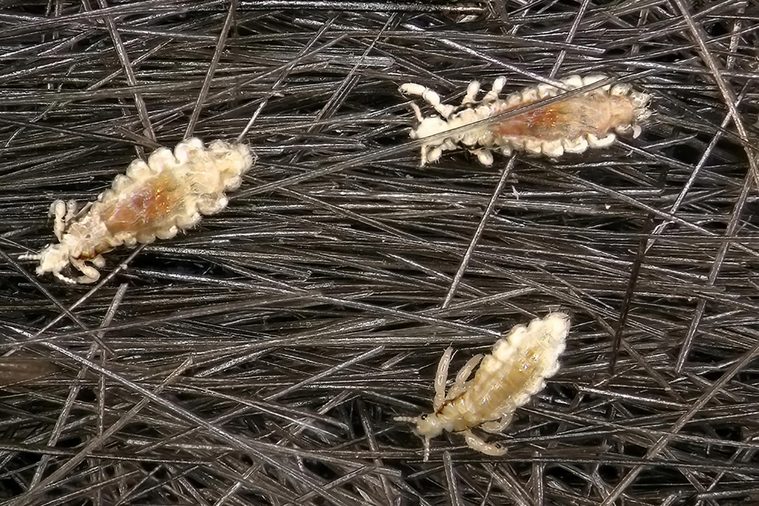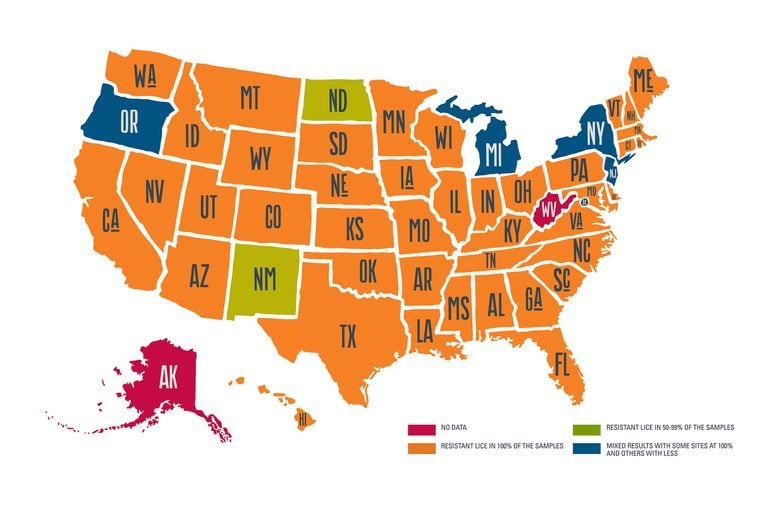This Map Shows Where Lice Has Become Resistant to Standard Treatments
Updated: Apr. 26, 2021
Lice is a four-letter word in more ways than one, as many parents will tell you. What's worse, it's becoming resistant to standard treatments across the country.

Head lice can be super gross and even a little scary. Symptoms of head lice are not just itch but sometimes pain as well, and they are highly contagious, which is why you’ll need to hot-wash bed sheets, and sterilize combs, hats, and more to eradicate the bugs if you’ve got an infestation. Unfortunately, lice are getting harder and harder to eradicate. According to a new report from the Journal of Entomology, there’s been a rise in the last few years of treatment-resistant lice. Yes, sadly these lice don’t respond to the standard over-the-counter treatments.
This map shows where there is now an epidemic of treatment-resistant lice.
 As you can see, 42 out of 50 states are now grappling with the problem of head lice that are resistant to OTC treatments. In fact, the effectiveness of standard treatments has declined by 25 percent—a level that’s no better than a placebo, according to a recent article published in Pediatric Dermatology. “Lice have adapted and can filter out most of the OTC products today, especially the traditional products that contain Permethrin, like Rid and Nix,” according to the website of The Center for Lice Control. “If you use one of these products, then you can have problems getting all the lice out, as bugs and eggs often survive the first treatment.”
As you can see, 42 out of 50 states are now grappling with the problem of head lice that are resistant to OTC treatments. In fact, the effectiveness of standard treatments has declined by 25 percent—a level that’s no better than a placebo, according to a recent article published in Pediatric Dermatology. “Lice have adapted and can filter out most of the OTC products today, especially the traditional products that contain Permethrin, like Rid and Nix,” according to the website of The Center for Lice Control. “If you use one of these products, then you can have problems getting all the lice out, as bugs and eggs often survive the first treatment.”
But don’t completely panic yet. This doesn’t mean you’ll always have creepy crawlies invading your child’s head and your home forever.
Although most people don’t realize it, there are prescription medications that knock out even the most stubborn lice:
- Sklice (ivermectin), a topical cream that stays on the head for 10 minutes and is said to kill 95 percent of lice without the need for combing.
- Ulesfia (benzyl alcohol), a non-toxic cream that is not actually a pesticide but works by coating the hair and suffocating the lice; it gets applied to the hair for 10 minutes and then rinsed off.
- Ovide (malathion lotion), which works by paralyzing and killing lice; it gets applied to the hair and left on for 8 to 12 hours before getting rinsed off.
According to Kenneth Polin, MD, a pediatrician at Lurie Children’s Hospital of Chicago, prescription medications are the way to go to ensure that lice are eliminated the first time. “I tell families not to bother with the over-the-counter stuff—it’s not consistently effective,” he has said. By contrast, the prescription meds are a home run. “I’ve not seen any resistance personally and I’ve not seen anything about resistance in the medical journals either,” he told today.com.
If you discover that your children have lice, consider calling your pediatrician for a prescription. You can treat lice quickly and effectively by taking action quickly, he adds. Also make sure you take bed linens, coats, hats, and anything else your kids share, and send them through the washing machine on hot—130°F (54.5°C) or higher, according to WebMD. You’ll also have to clean furniture and whatever else your kids lay their heads on.
If you’re worried that prescription medications must be toxic, like pesticides, Dr. Polin assures us that they’re safe, but you can always try these home remedies for lice, including tea tree oil for lice, first, along with combing wet hair with a fine-toothed comb to remove nits. Expect to re-treat after 7 to 9 days, as the first treatment may not kill recently laid eggs.